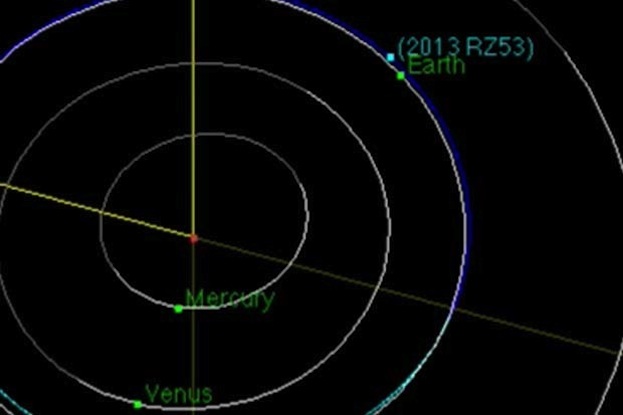Tiny Asteroid Gives Earth a Close Shave

A small asteroid harmlessly zipped by Earth closer than the orbit of the moon today (Sept. 18).
At just 3 to 10 feet (1 to 3 meters) in diameter, the tiny asteroid — called 2013 RZ53 — would have burned up in Earth's atmosphere if it were on a collision course with the planet, scientists say. 2013 RZ53 made its closest approach to Earth at 6:50 p.m. EDT (2250 GMT).
The space rock was expected to miss the planet by about 151,000 miles (243,000 kilometers) when it gave Earth a close shave, according to a pre-flyby Twitter post put out by NASA's Near-Earth Object Program (@AsteroidWatch) based at the agency's Jet Propulsion Laboratory in Pasadena, Calif. [Potentially Dangerous Asteroids (Images)]
For comparison, the moon orbits Earth at an average distance of about 239,000 miles (384,600 km).
Scientists working with the Mount Lemmon Survey at the University of Arizona discovered 2013 RZ53 on Friday (Sept. 13), and the space rock was observed 34 times through Monday (Sept. 16), according to the Minor Planet Center. Using information gleaned from those observations, researchers put together an animation of 2013 RZ53's path through the solar system.
The Mount Lemmon Survey is part of the Catalina Sky Survey, a NASA-sponsored program that looks out for and tracks potentially hazardous asteroids.
Researchers think that 2013 RZ53 is a member of the Apollo family of near-Earth asteroids. The meteor that exploded over the Russian city of Chelyabinsk in February is suspected to be part of this group. The Russian meteor was much larger than 2013 RZ53, at an estimated 56 to 66 feet wide (17 to 20 m).
Get the Space.com Newsletter
Breaking space news, the latest updates on rocket launches, skywatching events and more!
A telescope in Hawaii discovered the 10,000th near-Earth object earlier this year, but there are still many more out there to detect and track. NASA scientists have found more than 90 percent of the mountain-sized near-Earth asteroids, behemoths larger than 0.6 miles (1 km) that could cause problems on a global scale if they were to impact the planet.
But just 30 percent of the roughly 15,000 near-Earth asteroids that are 460 feet (140 m) wide have been catalogued, and less than 1 percent of the more than 1 million objects that are about 100 feet (30 m) in diameter have been found, NASA estimates.
So far this month, scientists and amateur astronomers submitting data to the Minor Planet Center — a clearinghouse for information about minor bodies like asteroids and comets — have found 77 near-Earth objects and two comets. This year alone, observers have found 678 near-Earth objects and 46 comets.
Editor's Note: This story is an updated version of an earlier story about asteroid 2013 RZ53 posted today.
Follow Miriam Kramer @mirikramer and Google+. Follow us @Spacedotcom, Facebook and Google+. Original article on SPACE.com.

Join our Space Forums to keep talking space on the latest missions, night sky and more! And if you have a news tip, correction or comment, let us know at: community@space.com.

Miriam Kramer joined Space.com as a Staff Writer in December 2012. Since then, she has floated in weightlessness on a zero-gravity flight, felt the pull of 4-Gs in a trainer aircraft and watched rockets soar into space from Florida and Virginia. She also served as Space.com's lead space entertainment reporter, and enjoys all aspects of space news, astronomy and commercial spaceflight. Miriam has also presented space stories during live interviews with Fox News and other TV and radio outlets. She originally hails from Knoxville, Tennessee where she and her family would take trips to dark spots on the outskirts of town to watch meteor showers every year. She loves to travel and one day hopes to see the northern lights in person. Miriam is currently a space reporter with Axios, writing the Axios Space newsletter. You can follow Miriam on Twitter.









